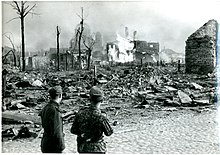
Narva is a municipality and city in Estonia. It is located in the Ida-Viru County, at the eastern extreme point of Estonia, on the west bank of the Narva river which forms the Estonia–Russia international border. With 53,626 inhabitants Narva is Estonia's third largest city after capital Tallinn and Tartu.

Harju County, is one of the fifteen counties of Estonia. It is situated in Northern Estonia, on the southern coast of the Gulf of Finland, and borders Lääne-Viru County to the east, Järva County to the southeast, Rapla County to the south, and Lääne County to the southwest. The capital and largest city of Estonia, Tallinn, is situated in Harju County. Harju County is the largest county in Estonia in terms of population, as almost half (45%) of the Estonia's population lives in Harju County.
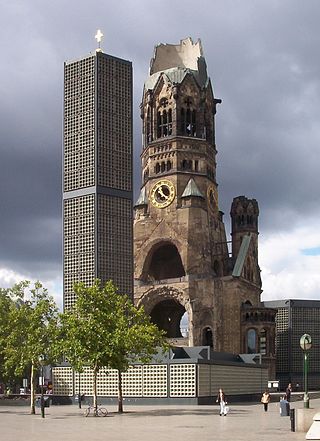
Berlin, the capital of Nazi Germany, was subject to 363 air raids during the Second World War. It was bombed by the RAF Bomber Command between 1940 and 1945, the United States Army Air Forces' Eighth Air Force between 1943 and 1945, and the French Air Force in 1940 and between 1944 and 1945 as part of the Allied campaign of strategic bombing of Germany. It was also attacked by aircraft of the Red Air Force in 1941 and particularly in 1945, as Soviet forces closed on the city. British bombers dropped 45,517 tons of bombs, while American aircraft dropped 22,090.3 tons. As the bombings continued, more and more people fled the city. By May 1945, 1.7 million people had fled.

The Battle of Narva Bridgehead was the campaign that stalled the Soviet Estonian operation in the surroundings of the town of Narva for six months. It was the first phase of the Battle of Narva campaign fought at the Eastern Front during World War II, the second phase being the Battle of Tannenberg Line.

The Battle of Narva was a World War II military campaign, lasting from 2 February to 10 August 1944, in which the German Army Detachment "Narwa" and the Soviet Leningrad Front fought for possession of the strategically important Narva Isthmus.

The Battle of Tannenberg Line or the Battle of the Blue Hills was a military engagement between the German Army Detachment Narwa and the Soviet Leningrad Front. They fought for the strategically important Narva Isthmus from 25 July–10 August 1944. The battle was fought on the Eastern Front during World War II. The strategic aim of the Soviet Estonian Operation was to reoccupy Estonia as a favorable base for the invasions of Finland and East Prussia. Waffen-SS forces included 24 volunteer infantry battalions from the SS Division Nordland, the SS Division Langemarck, the SS Division Nederland, and the Walloon Legion. Roughly half of the infantry consisted of the personnel of the 20th Waffen Grenadier Division of the SS. The German force of 22,250 men held off 136,830 Soviet troops. As the Soviet forces were constantly reinforced, their overall casualties are estimated by Estonian historian Mart Laar to be 170,000 dead and wounded.

The Baltic Sea campaigns were conducted by Axis and Allied naval forces in the Baltic Sea, the Gulf of Bothnia, the Gulf of Finland and the connected lakes Ladoga and Onega on the Eastern Front of World War II. After early fighting between Polish and German forces, the main combatants were the Kriegsmarine and the Soviet Navy, with Finland supporting the Germans until 1944 and the Soviets thereafter. The Swedish Navy and merchant fleet played important roles, and the British Royal Navy planned Operation Catherine for control of the Baltic Sea and its exit choke point into the North Sea.

In the course of Operation Barbarossa, Nazi Germany invaded Estonia in July–December 1941, and occupied the country until 1944. Estonia had gained independence in 1918 from the then-warring German and Russian Empires. However, in the wake of the August 1939 Nazi-Soviet Pact, the Soviet Union had invaded and occupied Estonia in June 1940, and the country was formally annexed into the USSR in August 1940.
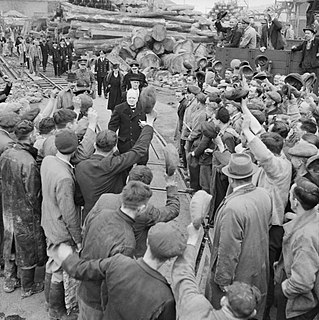
The Plymouth Blitz was a series of bombing raids carried out by the Nazi German Luftwaffe on the English city of Plymouth in the Second World War. The bombings launched on numerous British cities were known as the Blitz.

During World War II, the Estonian capital Tallinn suffered from many instances of aerial bombing by the Soviet air force and the German Luftwaffe. The first bombings by Luftwaffe occurred during the Summer War of 1941 as part of Operation Barbarossa. A number of Soviet bombing missions to then German-occupied Tallinn followed in 1942–1944.
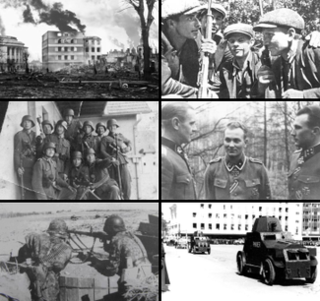
Estonia declared neutrality at the outbreak of World War II (1939–1945), but the country was repeatedly contested, invaded and occupied, first by the Soviet Union in 1940, then by Nazi Germany in 1941, and ultimately reinvaded and reoccupied in 1944 by the Soviet Union.
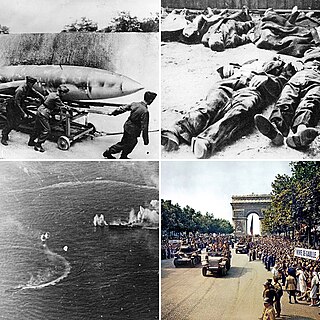
This is a timeline of events that occurred during 1944 in World War II.
The Tallinn offensive was a strategic offensive by the Red Army's 2nd Shock and 8th armies and the Baltic Fleet against the German Army Detachment Narwa and Estonian units in mainland Estonia on the Eastern Front of World War II on 17–26 September 1944. Its German counterpart was the abandonment of the Estonian territory in a retreat codenamed Operation Aster.

The Tartu offensive operation, also known as the Battle of Tartu and the Battle of Emajõgi was a campaign fought over southeastern Estonia in 1944. It took place on the Eastern Front during World War II between the Soviet 3rd Baltic Front and parts of the German Army Group North.

Estonian partisans, also called the Forest Brothers were partisans who engaged in guerrilla warfare against Soviet forces in Estonia from 1940 to 1941 and 1944 to 1978.

This is a sub-article to Leningrad–Novgorod Offensive and Battle of Narva.

The Narva offensive was an operation conducted by the Soviet Leningrad Front. It was aimed at the conquest of the Narva Isthmus from the German army detachment "Narwa". At the time of the operation, Joseph Stalin, the supreme commander of the Soviet Armed Forces, was personally interested in taking Estonia, viewing it as a precondition to forcing Finland out of the war.

This is a sub-article to Battle of Narva.

The Summer War was the occupation of Estonia during the Second World War. It was fought between the Forest Brothers (Metsavennad), the Omakaitse, and the Wehrmacht's 18th Army against the forces of the 8th Army of the USSR and the NKVD.


